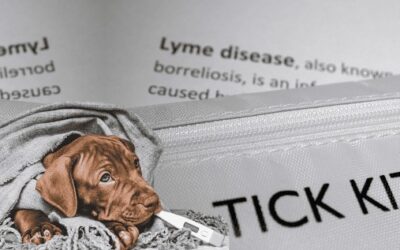Spider Bites On Dogs: How to Treat Them?

Dogs love to explore, sniff around, and get into things, which sometimes means they cross paths with creepy crawlies like spiders. Most spiders aren’t looking for trouble, but they can bite if they feel threatened. And unfortunately, our curious pups sometimes get too close for comfort.
While the majority of spider bites won’t harm your dog, a few species, like the black widow or brown recluse, carry venom that can pose serious health risks. That’s why being able to recognize the signs of a bite and knowing what to do next is an important part of being a prepared and caring dog owner.
Let’s break it down so you know how to spot a spider bite, what steps to take, and how to help your dog feel better, fast.
Where Spider Bites Happen (and How to Prevent Them)
Spiders tend to hide in quiet, undisturbed places like basements, garages, sheds, and woodpiles. These are also spots where your dog might wander while playing or exploring. Doing a quick check and regular cleaning in these areas can go a long way in keeping your dog safe.
Prevention Tips:
- Sweep out cobwebs and check for spiders in corners.
- Seal cracks and gaps in walls or doors.
- Store outdoor gear and pet toys in closed bins.
- Keep your dog on a leash when exploring new or wooded areas.
What a Spider Bite Looks Like on a Dog
It’s not always easy to spot a bite through all that fur, but there are a few things to watch for.
Common signs include:
- A small, red bump or puncture wound.
- Swelling, warmth, or tenderness around the area.
- Your dog may lick, scratch, or whine when the area is touched.
In more serious cases, you might see:
- Open wounds or skin damage (especially with recluse spider bites).
- Lethargy, vomiting, fever, or muscle tremors, which may indicate that the venom is spreading.
What to Do If You Think Your Dog Got a Spider Bite
Acting quickly and calmly can help reduce any discomfort or complications. Here’s how to respond if you suspect a bite:
- Stay calm and gently check the area.
- Clean the wound with mild soap and water. Avoid using alcohol or hydrogen peroxide, which can irritate the skin.
- Apply an old compress to reduce swelling and relieve pain.
- Watch for symptoms, especially any signs of your dog acting differently, becoming lethargic, or showing discomfort.
When It’s Time to Call the Vet
Not all bites need emergency care, but if your dog shows signs of a more serious reaction—like vomiting, severe pain, or difficulty moving—it’s time to call your vet.
Also, if you suspect the bite is from a venomous spider (like a black widow or brown recluse), don’t wait. Quick action can make a big difference.
Your vet may recommend:
- Pain relievers or anti-inflammatory medication.
- Antihistamines to reduce swelling or allergic reactions.
- In some cases, antivenom or hospitalization if symptoms are severe.
Treatment When Your Dog Got a Spider Bite
As by Caroline Coile, PhD wrote in the AKC article: “If you suspect your dog has been bitten by a black widow, consider it an emergency and contact your veterinarian immediately. No home treatment is available.
Blood tests may reveal an elevated enzyme called creatine kinase, which can be indicative of muscle damage caused by the venom. However, there is no definitive test to diagnose a black widow bite specifically.
Treatment is mostly supportive, meaning it focuses on treating the symptoms. That can include IV fluids, muscle relaxers, pain medication, medications to combat seizures, and anti-nausea medication.”
Special Care for Different Spider Bites
Black Widow Bites:
These bites can cause muscle tremors, extreme pain, or even collapse. Keeping your dog calm and getting them to a vet right away is essential. Treatment may include antivenom and close monitoring.
Brown Recluse Bites:
These can lead to serious skin damage, so watch for wounds that worsen over time. Vets may need to clean the area, prescribe antibiotics, and manage pain. Early care helps prevent complications.
Chilean Recluse Bites: Rare but more potent than the brown recluse, these bites can cause both tissue damage and systemic illness.
Red Widow Bites: Less common but still dangerous, especially in certain regions. Dogs may experience muscle cramping or pain.
Brown Widow Bites: Generally milder than black widows, but still uncomfortable. Keep your dog comfortable and talk to your vet if symptoms don’t improve or worsen.
How Can Pet Insurance Help You if Your Dog Needs Treatment?
Pet insurance can be a valuable tool in managing the costs of treating a dog’s veterinary expenses. By having a pet insurance policy in place, you can have peace of mind knowing that you can provide medical care for your furry companion without worrying about the financial burden. Pet insurance can help cover the costs of veterinary consultations, diagnostic tests, medications, and even specialized treatments if required.
Reimbursement
This method is the most common for pet insurance companies. You pay out of pocket for the veterinarian bill, and then the insurance company reimburses you for what’s covered under the insurance plan. The steps look like this.
- You pay the vet bill after your dog’s visit.
- You fill out the pet insurance claim form.
- Submit the claim form and other required documentation to the insurer.
- After the claim is approved, you will be reimbursed for eligible expenses.
What Does Odie Pet Insurance Cover?
Pet insurance covers various veterinary expenses, providing financial protection and peace of mind for pet owners. Here are the details of the coverage options offered by Odie Pet Insurance:
Illness & Injury Plan
The Illness & Injury Plan is an all-inclusive insurance plan designed to cover a wide range of medical needs for your pet. This plan includes comprehensive coverage for various illnesses, injuries, and veterinary services. Some of the covered items include:
- Veterinary exams and consultations
- Diagnostics (e.g., X-rays, lab tests)
- Prescribed medications
- Surgeries and hospitalization
- Rehabilitation, acupuncture, or chiropractic treatments
- Medically necessary supplies
- Euthanasia and cremation
The Wellness Plan
The Wellness Plan is a monthly membership that focuses on preventive care and covers routine veterinary services.
- Provides reimbursements for routine care items such as wellness visits (exams and vaccines), testing and parasite prevention, dental cleanings and at-home dental care, vitamins, supplements, and more.
- Through Odie’s partnership with Petivity, a leader in smart pet products and proactive care, Wellness Plan members can also receive reimbursements for Petivity devices and health kits, as well as eligible Purina food and supplements.
- Total reimbursement up to $700 per year.



